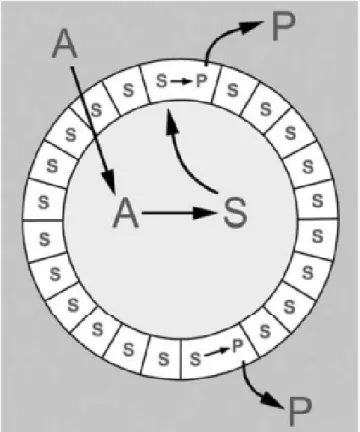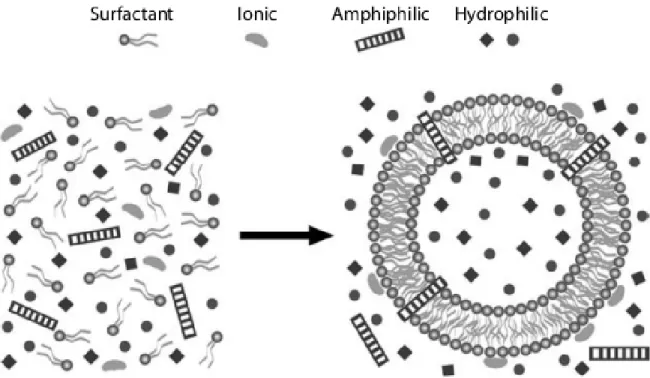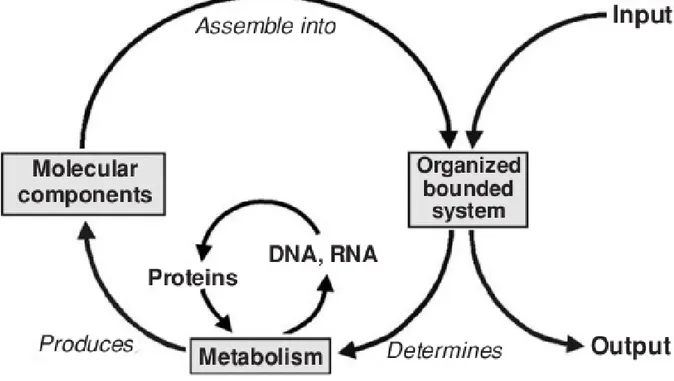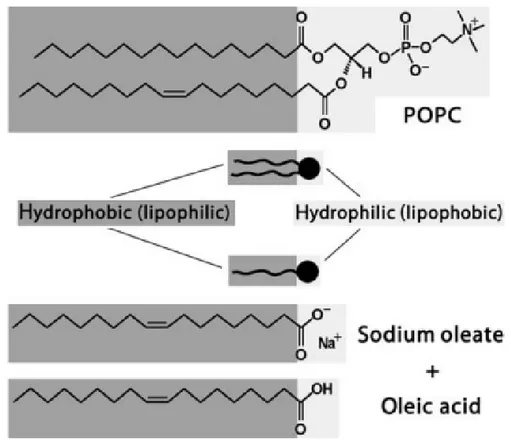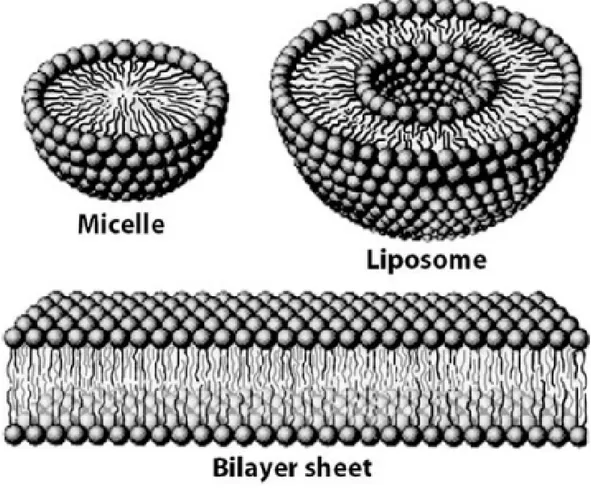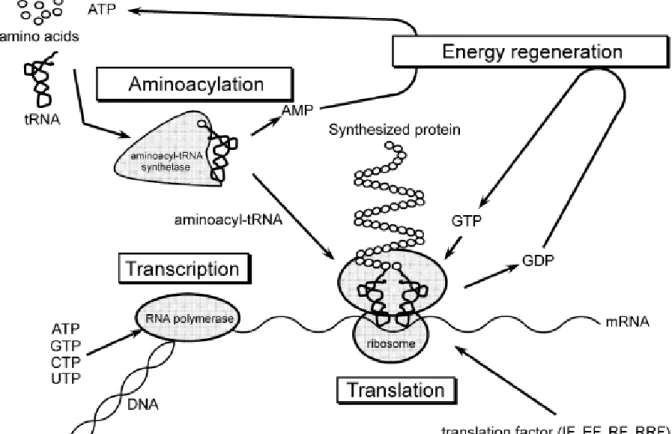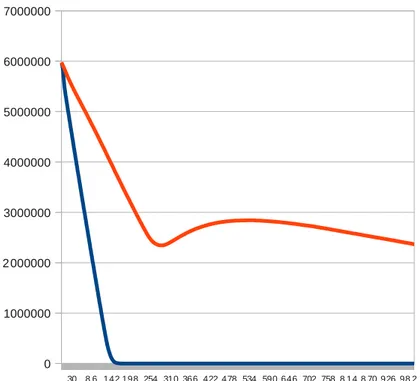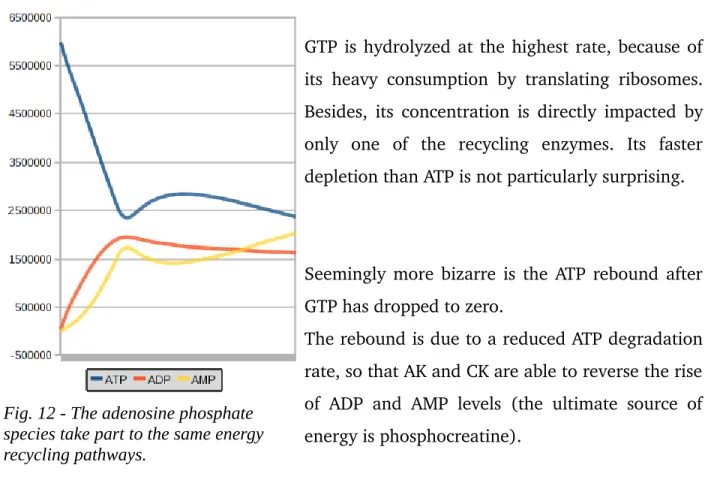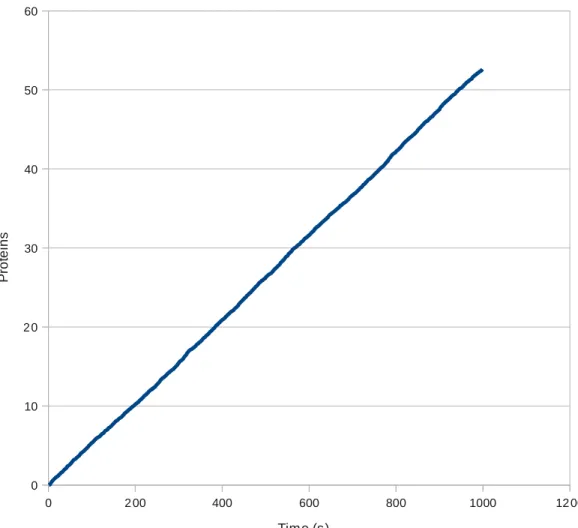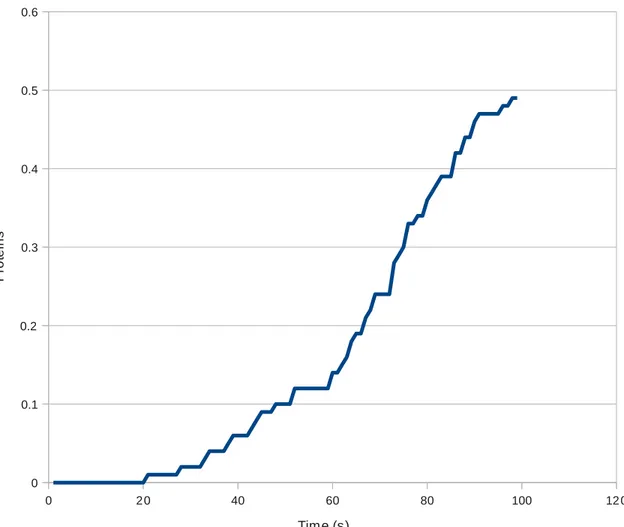UNIVERSITÀ DI PISA
FACOLTÀ DI SCIENZE MATEMATICHE, FISICHE E NATURALI
Corso di Laurea Specialistica in Scienze e Tecnologie Biomolecolari
A
NI
NS
ILICOS
TUDYOF
P
ROTEINS
YNTHESIS INQ
UASIC
ELLULARS
YSTEMSR
ELATOREC
ANDIDATOP
ROF. R
OBERTOM
ARANGONIL
ORENZOL
AZZERINIO
SPRIC
ORRELATORIP
ROF. G
IOVANNIC
ERCIGNANIP
ROF. P
IERL
UIGIL
UISIS
UMMURY
OF
C
ONTENTS
R
IASSUNTO4
A
BSTRACT5
1 I
NTRODUCTION1.1 S
TUDIESON
THE
O
RIGINOF
L
IFE. . . 8
1.2 A S
YNTHETICB
IOLOGYA
PPROACH. . . .
. . . .
. 9
1.3 T
OWARDA
S
ELF
REPLICATINGV
ESICLE. . . 12
1.4 E
NGINEERINGV
ESICLES. . . 16
1.5 T
HEP
URES
YSTEM. . . 20
1.6 E
MERGENCE& S
YSTEMSB
IOLOGY. . . 22
1.7 S
YSTEMSD
YNAMICS: S
TOCASTIC, D
ETERMINISTICM
ODELS. . . 24
2 S
TATE
OF
THEA
RTAND
T
HESISA
IM28
3 M
ETHODOLOGY3.1 QDC
ANTITS
I
NPUT/O
UTPUT. . . 31
3.2 S
IMULATIONS&
SPECIESDISTRIBUTIONS
. . . .
33
4 R
ESULTSAND
D
ISCUSSION4.1 P
URE
SYSTEMF
ORMALIZATION. . . 35
4.2 C
ONSTANTSE
VALUATION. . . 37
4.3 S
YSTEMSA
NALYSIS. . . 38
5 C
ONCLUSIONS56
R
IASSUNTO
La creazione di forme di vita artificiali in laboratorio è uno dei più ambiziosi obiettivi della Synthetic Biology. In aggiunta all'avanzamento delle nostre conoscenze sulle caratteristiche fondamentali comuni a tutti gli esseri viventi, ricreare la vita in laboratorio avrebbe notevole rilevanza per il dibattito scientifico riguardo l'origine della vita sulla Terra. Allo stato attuale, la ricerca si concentra su due obiettivi a brevemedio termine: la creazione di vescicole membranose che abbiano le caratteristiche favorevoli delle membrane cellulari attuali e la sintesi di sistemi genetici che, inseriti in tali vescicole, possano dirigerne l'autoreplicazione e l'automantenimento.Un particolare sistema di traduzione proteica in vitro, detto PURE system, incapsulato all'interno di liposomi costituisce un ambiente “quasicellulare”, ovvero un rudimentale apparato di espressione dell'informazione genetica con un metabolismo elementare. Esso è comunemente usato, fra l'altro, negli studi sull'evoluzione prebiotica. Un'esaustiva analisi delle sue vie metaboliche è pertanto desiderabile e costituirebbe un contributo potenzialmente rilevante per la ricerca scientifica su questo affascinante argomento. Per questi motivi, ci siamo proposti di realizzare un modello in silico del PURE system, su cui sperimentare i metodi di analisi tipici della Systems Biology al fine di ricavare informazioni sulle proprietà metaboliche di questo sistema e formulare predizioni sperimentalmente verificabili in wet lab.
In questa tesi si dà un comprensivo resoconto del nostro sviluppo del più dettagliato modello ad oggi disponibile del PURE system e dei risultati ottenuti dalle simulazioni stocastiche eseguite su di esso. Particolare attenzione è dedicata all'analisi della variazione dell'efficienza della resa proteica col volume liposomiale.
Abstract
Synthesizing life is one the most ambitious aim of Synthetic Biology. Besides having the potential to advance our general knowledge about the fundamental properties of all life forms, recreating life in the lab would give valuable insights about the origin of life on Earth. To date, research has been focusing on two complementary endeavors: the development of membranous compartments sharing the same desirable features of presentday cell membranes, and the synthesis of genetic systems to be inserted inside those compartments in order to direct their selfreplication and selfmaintenance.A specific in vitro translation system, named the PURE system, enclosed inside a liposome makes a 'quasicellular' environment: it has a rudimentary metabolism and provides an expression apparatus for genetic information. For those reasons, it is often used as a prototypical prebiotic system in synthetic biology studies. Therefore, an indepth analysis of the metabolic pathways of this system could be a useful contribution to scientific research about as fascinating a subject as the quest for artificial life. For all these reasons, we set out to develop an in silico model of the PURE system, in order to characterize its metabolic properties according to the analytic methods of Systems Biology, and giving experimentallytestable predictions about it.
This thesis gives a comprehensive account of our development of the most detailed PUREsystem model available to date, and of the results obtained by performing stochastic simulations with it. Particular focus is given to the analysis of protein yield efficiency in respect of vesicle volume.
“There is grandeur in this view of life, with its several powers, having been originally breathed into a few forms or into one; and that, whilst this planet has gone cycling on according to the fixed law of gravity, from so simple a beginning endless forms most beautiful and most wonderful have been, and are being, evolved.” Charles Darwin, On the Origin of Species. “Vaivra elohim ethataninim hagedolim veet kolnefesh hachayah haromeset asher shartsu hamaim leminehem veet kolof kanaf leminehu vayar elohim kitov.” [God created the great sea monsters, along with every particular species of living thing that crawls, with which the waters teem, and every particular species of winged flying creature; God saw that it was good.] Anonymous, Genesis 1:21.
1. Introduction
1.1. Studies On the Origin of Life
Evolution could well be argued to be the apex and culmination of the scientific enterprise. An elegant, powerfully explicatory theory, it does away with the many untenable assumptions about life rife in prescientific thought. It also provides us with an invaluable intellectual framework to interpret and understand biological facts. Indeed, as noted evolutionary biologist Theodosius Dobzhansky remarked, “Nothing in biology makes sense except in the light of evolution” [Dobzhansky, 1973]. Darwin's theory maintains that any nonisolated system endowed with specific properties namely, selfreplication with occasional mutations impacting the replication rate will spontaneously undergo a gradual increase in organized complexity. In the end, such a system shall differ from any other nonDarwinian structure in the universe in its display of 'teleonomy', or the appearance of purposefulness [see, for instance, Monod 1970]. The central importance of Darwinian evolution in modern biology is underscored by this fact, that evolution defines life itself as a natural phenomenon. The two great frontiers that lie at the extremes of evolutionary history, namely the origin of the first selfreplicating system and the functioning of evolution's most complex product (the human brain), stand as the last, most arduous and most engaging challenges biologists are left to face.
The origin of life appears at first as an especially intractable problem because of its historical nature, and thus its seeming nontestability. However, Darwin himself urged to resist epistemological pessimism on these matters, while discussing specifically the origin of humans:
“It has often and confidently been asserted, that man's origin can never be known: Ignorance more frequently begets confidence than does knowledge: it is those who know little, not those who know much, who so positively assert that this or that problem will never be solved by science.” [Darwin, 1871] Three hypotheses have historically been set forth as regard the origin of life on this planet:
1. abiogenesis, the emergence of life from nonliving matter through a gradual increase in chemical complexity ('molecular evolution');
2. panspermia, the 'insemination' of the Earth by life forms, or direct precursors thereof, brought here by fallen space objects (meteorites, etc);
3. divine intervention.
The last two proposals merely defer the problem, and so are not satisfactory explanations. Panspermia has nothing to say about how our alleged alien ancestors came to be, while divine creation does not account for the origin of the divine creator (who must be assumed to be an extremely complex entity, thus actually aggravating the problem we seek to address). Besides, creationism flouts per se the naturalistic axiom of science, and makes no testable predictions.
We must conclude abiogenesis is the only reasonable possibility.
1.2. A Synthetic Biology Approach
While we will probably never come to know for sure the exact series of physical chemical events which led to the birth of the first cell on this planet, we can certainly try to prove a process of this kind is possible in nature by producing the transition from inanimate matter to life in the laboratory.
Aside from its demonstrative importance, the quest for artificial life by scientists could also yield valuable clues concerning the actual probability of abiogenesis.
Is the emergence of a selfreplicating molecule the frequent and inescapable outcome of the laws of nature acting on any systems similar to early Earth? Or is it an extremely rare occurrence brought about by unlikely stochastic events which took billions of years over trillions of planets in order to happen only once, by chance, on this Earth? 'Everything existing in the universe is the fruit of chance and necessity' according to the ancient Greek philosopher Democritus. That is also a basic tenet of science. Should all of our efforts to create life consistently fail, abiogenesis would not be disproved (since it's impossible to definitely disprove anything). Instead, that would suggest life may not, after all, be a necessary product of the universe. The design and construction of living systems from scratch (the socalled 'bottomup approach') is within the scope of a relatively new branch of biology named 'synthetic biology'. This is contrasted to another path to the minimal cell, called the topdown approach, which seeks to discover the minimal set of genes necessary and sufficient to support life by stripping an existing organism (typically a simple bacterium, e.g. from the Mycoplasma genus) of all 'superfluous' features for life in the lab. Before setting out to create a minimal living system in the lab, it is undoubtedly useful to define what a living system actually is. Alexander Oparin, the Russian biochemist who developed the first abiogenetic theory, proposed a 6property based definition [Oparin, 1961]. A compartmentalized system is defined as living if it: 1. exchanges materials with the surrounding medium; 2. can grow; 3. can form a multiplying population; 4. can selfreplicate; 5. is capable of movement; 6. can react to external stimuli.
We anticipated early on in this chapter that the current consensus in biology holds that any life form, wherever in the universe and however weird it might be, must have come about as a result of a process logically equivalent to Darwinian evolution, and this also sets it apart from every other entity. This fundamental property has been more recently used to underpin the socalled 'NASA definition of life' (i.e., life is any selfsustaining chemical system capable of Darwinian evolution). That is not, however, a very good operational definition for people seeking to create a minimal living system, since it is difficult to use as a practical criterion to assess a single specimen: Darwinian evolution manifests itself at the population level, and is also a process operating through time, not instantaneously. A popular practical definition among researchers focuses on homeostasis: “a system can be said to be living if it is able to transform external matter/energy into an internal process of selfmaintenance and production of its own components. ” [Luisi, 2006]
Fig. 1 – An elementary life form? This
compartmentalized system homeostatically maintains its own separation from the outside world.
1.3. Toward a SelfReplicating Vesicle
The abovestated 'pragmatic' definition implies an inside/outside dichotomy, i.e. the requirement of a membrane as a boundary for the prospected (artificial or otherwise) living system. Therefore, the synthesis of a compartmentalized 'protocell' capable to store and express genetic information has been a prominent research focus. Various experimental strategies are viable to achieve this goal, but all of them take advantage of a proclivity by certain simple chemical systems for selforganization. Micelle assembly is one such process. An aqueous mixture of amphipathic molecules beyond a threshold concentration (critical micelle concentration, 'CMC') spontaneously forms spherical compartments. The local order increase is offset by an even greater increase in disorder of the system at large, because of the water molecules 'set free' from their interactions with the amphipaths' hydrophobic tails. The general entropy of the mixture increases, thus satisfying the Second Principle of Thermodynamics, despite the local increment in organized complexity. Reverse micelles (spherical surfactant aggregates in an apolar solvent) and liposomes (spherical surfactant bilayers in water) are additional types of aggregates which self organize in solution. Unlike micelles, they have an internal cavity where hydrophilic molecules (e.g., nucleic acids, proteins) can be entrapped. Their formation, interestingly, is autocatalytic: organized surfactant bilayers speed up their own selfassembly once a membrane 'seed' has formed, analogously to crystal nucleation.
This peculiar formation kinetics may have some bearing on the distribution of the chemical species entrapped inside the vesicles (more on this later).
Fig. 3 – Types of aggregates formed by amphipathic molecules. (A) Monolayer; (B) bilayer; (C) liquid-crystal phase lamellar; (D) micelles; (E) hexagonal micelles; (F) liposomes; (G) reverse micelles.
Fig. 2 – An example of molecular self-organization. Molecules with both polar and apolar regions spontaneously assemble in solution to form an ordered structure.
Elementary autopoietic structures such as liposomes are not living, since autopoiesis is a necessary but not sufficient condition for life [Luisi, 2006]. Nonetheless, liposomes remain attractive as protocellular precursors because of their large interface area, which could allow for efficient materials exchange, and because of their ability to grow and divide.
Indeed, liposomes, as well as micelles and reverse micelles, can incorporate free hydrophobic precursors (e.g., fattyacid methyl esters) and convert them into membrane components. If the uptake rate is greater than the degradation rate of their own constituents, the vesicles grow until either they reach a homeostatic equilibrium or they divide [Walde, 1994]. The basic requirements for a minimal synthetic living system could be fulfilled by a liposome containing a genetic molecule expressing the metabolic network necessary to its own replication and maintenance, and to the coupling of the 'genotype' replication rate with the vesicle division rate. Various attempts have been made toward such a 'self encoding' system. For instance, [Kita et al., 2008] have liposomeencapsulated a Q replicase, an RNAβ dependent RNA polymerase, along with its own template RNA, and reconstituted translation factors as expression machinery.
While successfully selfreplicating, this 'quasicellular' system is not selfsustaining: there is no metabolic regeneration of substrates and enzymes, so that liposomes undergo substrate depletion and enzymatic inactivation. Furthermore, it suffers from low replication efficiency and there is no coupling mechanism between genotype replication and vesicle division.
Fig. 4 - A self-replicating genetic system
The latter is an essential feature, both for evolvability and homeostasis: “prior to cell division, and in parallel with DNA replication, dividing cells must grow homeostatically, preserving the concentrations of thousands of components by denovo metabolismbased synthesis. Only then may fission result in two identical progeny cells.” [Luisi, 2006]. Unfortunately, a coupling mechanism has so far eluded implementation in synthetic approaches to the study of the origin of life.
1.4. Engineering Vesicles
The molecular structure of a particular surfactant influences the form and volume of its aggregates. [Luisi, 2006]
The V/(a x l) ratio where V is the surfactant volume, a the head area, l the tail length is used to empirically determine what aggregate the surfactant is expected to form. If V/(a x l) ~ 1, then bilayers will assemble. If V/(a x l) < 1, then micelles are likely to appear. If V/(a x l) > 1, then reverse micelles will probably emerge. The molecular geometry is not the only factor. The nature of the hydrophilic head group (anionic, cationic, zwitterionic, nonionic) has also bearing on the aggregates shape and volume.
Environmental parameters (e.g., salt concentration) can also be manipulated to make larger or smaller aggregates. Liposomes are usually formed by spontaneous aggregation of fatty acids or palmitoyl oleoylphosphatidylcholine (POPC) when a concentrated aqueous or alcoholic solution is poured into water (injection method). The water may contain solutes we wish to entrap inside the newlyformed vesicles. Alternatively, a lipid film can be prepared by evaporating an organic solution, then water is added and the mixture stirred so as to generate a vortex. Fig. 6 - Surfactant molecule
Fig. 7 - Types of vesicle constituents
No matter what the preparation method, we always end up with a mixture of heterogeneouslysized liposomes (typically, 202000 nm), sizedistributed in a controllable manner according to the particular experimental conditions set. Giant vesicles up to 100 µm can be obtained by variant methods, e.g. electroformation [cf. Angelova, 1988].
Liposomes do not fuse, so their sizes do not level out (unlike micelles), and are metastable, i.e. they precipitate after a few days in solution (again unlike micelles). They are also poorly permeable, unlike biological membranes: entrapped solutes do not easily leak out, but even water and glycerol have great difficulty in diffusing inside [cf., e.g., Swairjo, 1994]. Table 1 shows some interesting geometrical properties of unilamellar (simple single bilayer) POPC liposomes. It is relevant to note here one implication: the smaller the internal liposome volume, the lesser the total enclosed volume by all liposomes (in conditions of constant initial POPC concentration, and fixed reaction total volume).
For instance, 100nm liposomes have an internal volume of 3.74 x 1012 µL; a 1 L solution of 10 mM POPC has a total liposomeenclosed volume of 66.9 mL, or 6.69% of the total volume.
500nm liposomes have an internal volume of 5.12 x 1010 µL; a 1 L solution of 10 mM POPC has a combined internal volume of 355.9 mL, or 35.59% of the total volume.
1.5. The PURE System
Most of the attempts to create a selfsustaining selfreplicating protocell make use of existing or in vitro evolved proteins in order to replicate and express the genetic molecule. One common expression system currently in widespread use is the socalled 'PURE' (Protein synthesis Using Recombinant Elements) system [Ueda, 2001]. The PURE system was developed as a cellfree recombinant alternative to wholecell prokaryotic or wheatgerm extracts to provide a functional translation machinery for a wide range of applications, from biotechnology to synthetic biology. Crude extracts suffer from translationindependent energy depletion and low efficiency due to the presence of proteases and nucleases. The PURE system comprises ~80 different molecular species (see Appendix A for a complete list), representing the E. coli translational machinery, fused with an hexa Histidine tag for easy purification. These constructs are cloned and overexpressed in E. coli cells, and later retrieved by Ni2+affinity chromatography. Ribosomes are uniquely isolated by sucrosedensitygradient centrifugation. The isolated compounds are then mixed in vitro in fixed ratios and finally evaluated for activity by measuring the translation rate of a standard transcript (DHFR mRNA).
This expression system is easy to use: it works by simply adding to it the desired protein encoding mRNA (or DNA); it has a comparatively high efficiency; finally, it allows for the finetuning of the reaction conditions (temperature, additional factors, etc.) [Shimizu, 2005].
The PURE system's substrates, enzymes and cofactors recapitulate in vitro the following metabolic processes: 1. aminoacylation of tRNAs; 2. translation (initiation, elongation, termination); 3. regeneration of the energetic species (ATP, GTP). A fourth pathway is optional: 4. transcription.
As anticipated earlier, a PUREsystemenclosing liposome is a quasicellular environment in that it makes a compartmentalized genomeexpressing entity with a primitive metabolism.
A PUREenclosing liposome is of course not a living cell even if programmed to self replicate its own genetic molecule, because it lacks full homeostatic abilities and a genotypephenotype coupling mechanism. Nonetheless it can be regarded as a significant step toward the development of the first minimal living cell, or a cell capable of selfmaintenance, selfreproduction and evolution. Therefore, optimizing such a system could be extremely relevant for future research on artificial life. Studies about the efficiency of protein synthesis inside liposomes usually focus on Green Fluorescent Protein (GFP) expression, because of its ease of detection through simple spectrophotometry.
1.6. Emergence & Systems Biology
Prebiotic evolution consisted in a gradual increase of organized complexity by chemical systems. This increment was significant, and is then supposed to have led to the origin of life, because it caused those chemical systems involved to acquire emergent properties. 'Emergence' refers to the arising of novel characteristics of a system, which are not displayed by any of the system's elementary constituents. That is what is meant by saying that a complex, organized system is not equivalent to the mere sum of its parts (see, for instance, [Mill, 1843]).The emergent properties result from the selforganization process, and are caused by the interactions between the elementary components [Crick, 1980]. Therefore, while those systems are of course fully described by a reductionist approach as for their physical
chemical structure, many of their most interesting functions are not understandable by studying the elementary components singularly.
Studying their interactions is necessary instead.
Systems Biology is the name of the discipline aiming to understand the emergent behavior of biological entities by analyzing the interactions of their components (e.g., enzymes and reagents in a metabolic network).
The development of computational models of such systems is one of the main side objectives. The reason is that organized, complex systems, as are those studied by systems biology, are defined to have many parts displaying a high level of interconnectivity, typically across different scales (subsystems in a hierarchy), so the combinatorial possibilities for unexpected behavior are high to astronomically high [Corning, 2002]. Computers allow, at least to some extent, to handle those numbers and consequently infer the property of the modeled system as a whole.
Computer simulations of whole cells are currently unachievable for technical reasons (extreme complexity requires still unavailable computation power). Systems biological analyses focus on cell subsystems: gene networks, biochemical pathways, cell compartments; the knowledge pursued in the nearterm is about the systems dynamics, that is, how a system evolves through time.
Life itself can be considered an emergent property (see, for instance [Denton, 2007]), so methods developed for systems biology may have a central role in the advance of synthetic attempts at recreating life in the laboratory. That is especially so since the chemical systems used in synthetic biology as prebiotic precursors display a much lower complexity than presentday cells. Thus, they can be analyzed by currently available systems biology methods in search of interesting emergent properties, which may give fundamental clues as to whether one is indeed on the right path to synthesize a life form. This very thesis is a modest example of systems analysis applied to synthetic biology.
1.7. Systems Dynamics:
Stochastic, Deterministic Models
Deterministic formalizations were the first, historically, to be used in order to model (bio)chemical systems. Their time course was typically described by differential equations of the form: dXi/dt = ft (Xi,...,Xi,...,Xn), called the 'reaction rate equations', with ft being dependent on the specific reaction modeled.
Deterministic models of this kind are suitable for bulk reactions, where large numbers of molecules are involved. Their predictions are not verified for small systems though, where discreteness and chance exert a significant effect because noise is a fundamental factor of their dynamics. Such factors should be responsible for any increment in protein yield for smallvolume liposomes, and would be inevitably lost to a deterministic model.
Stochastic simulations, by contrast, more closely mimics the real molecular events underlying chemical reactions, taking into account randomness as a factor which may affect the macroscopic behavior in certain circumstances. Stochastic simulations are usually accomplished by means of simulation algorithms which are in themselves stochastic because they comprise at least one step dependent on a randomlygenerated number.
One of the most widely used stochastic simulation algorithms (SSAs) for biochemical systems was developed by Daniel Gillespie in 1977.
Gillespie's SSA treats chemical reactions as instantaneous events involving at most two molecules at a time. Onereagent reactions are intended to model internal transformations of the reagent molecule, while tworeagent reactions represent the
collision of two reagent molecules. Higherorder reactions must be construed as series of one or two molecule events. Participant species are assumed to have negligible local variations across the simulated system (i.e., they are assumed to be homogeneously distributed), so that we can ignore their exact position and velocity, and focus on their molecule number through time. If a system is made up of N chemical species S1,...,SN involved in M chemical reactions R1,...,RM taking place in a fixed volume , the time course of this system is given by theΩ state vector X(t) = ( X1(t) [...] XN(t) ), with Xi(t) being the molecule number of species Si at time t.
The initial state of the system must, of course, be known: X(t0) = x0. Each reaction Rj is defined by two parameters:
1. the statechange vector vj = ( v1j [....] vN j ), where vij is the molecule number variation affecting species Si after reaction Rj;
2. the propensity function aj, whose area under the curve gives the probability of reaction Rj taking place in in a certain time interval. That is: aΩ j(x)dt is the probability of Rj happening within [t; t + dt].
In the case of a unimolecular reaction, the propensity function looks like the following: aj (x) = cj xi, where xi is the molecule number of species Si and cj is constant such that cj dt is the probability of Si undergoing Rj within [t; t + dt].
As for twomolecule reactions, their propensity functions are similarly:
aj(x) = cj x1 x2, where x1, x2 are the molecule numbers of the two species taking part; or: aj(x) = cj xi (xi – 1)/2, if two molecules of the same species Si are reacting.
The probability that each species population change in time interval t is givenδ probabilistically by the socalled Chemical Master Equation (CME): , which in a deterministic system is reduced to the reaction rate equation: Exact solutions of the CME for X(t) are very hard to obtain, but various methods allow to get the same information by using a different probability function, p( , j | x, t)dt, whichτ describes what reaction Rj, out of all the possible ones, will occur in the system in the time interval [t + ; t + + dt). Specifically:τ τ The random variables and j are needed. One method to get them is called the directτ method. and uses the standard inversiongenerating method of Monte Carlo theory: two random numbers, r1 and r2, are selected from a uniform distribution so that:
The stochastic simulation algorithm gives the time course of the system by going through the following steps: 0. initialization of the system state x0 (t = t0) 1. evaluation of all propensity functions and their sum a0(x) 2. generation of random and jτ 3. firing of the chosen reaction, while the system is updated: t t + ; x x + v← τ ← j 4. output (x, t) 5. return to 1 or quit the simulation.
While Gillespie's SSA is comparatively fast and efficient, it suffers from similar drawbacks to other stochastic simulation methods.
Specifically, since reactions are simulated one at a time, if the reaction rates cover a significantly wide range, with the presence of very fast and/or very slow reactions (a condition called stiffness), i.e. if the evolution of the system occurs in significantly diverse time scales for different reactions, the slower reactions, disadvantaged over the faster ones, cause the simulation to proceed very slowly. There are various moreorless satisfactory getrounds to this problem, consisting of modifications of the SSA (cf., for instance, Gillespie's own slowscale SSA), or 'jumps' across simulation time intervals when propensities are set to 0 ( leaping) [Gillespie, 2007].τ
Besides stiffness, there are inherent limitations in the way Gillespie's SSA works, such as the inapplicability to anisotropic systems and the still high computational time requirements.
However, while waiting for the development of new, more universally applicable and more computationally parsimonious algorithms, Gillespie's SSA remains perhaps the most widely used algorithm in biochemical stochastic simulations because of its many advantages over currently available competitors.
2. S
tate of the Art
and
Thesis Aim
As expounded in the introduction, liposomes come in a variety of sizes, in the 20 nm 100 µm range. The size distribution is largely steerable by the conditions of the formation reaction. We have also elucidated the relevance of compartmentalized proteinexpression systems for the research on synthetic life, so that the importance of an indepth understanding of their metabolic pathways could be made clear. The primary aim of this thesis is to produce a computational model of one such system and to develop it to the highest possible standard of fidelity, by first studying its in silico properties and behavior in order to pinpoint exact parameters, or obtaining specific predictions, which will allow to experimentally validate it.
The Pure translation system was selected for this purpose. As a particular implementation of the general strategy outlined above we decided to study the efficiency of its major metabolic pathway, seeking both a means to experimentally validate the model, and to potentially make a real contribution to an important research focus.
Specifically, we assumed that the metabolic efficiency of translation in a liposome enclosed PURE system had a connection to vesicle volume. It is reasonable to assume that for extremely small compartments, substrate depletion would eventually cause the protein yield to drop to zero. On the contrary, it can be assumed that for very large vesicles, yield will slowly converge toward an asymptotic level. What about intermediate volumes? Collision theory for chemical reactions suggests that higherthanfirst order reactions, requiring the oriented collision of their randomly diffusing reagents, take place at a higher rate the smaller the reaction volume, since the probability of effective collisions is inversely proportional to it.
We do expect then an optimal volume for liposomes, where protein yield reaches an absolute maximum before dropping to zero for too small a compartment or abating to the asymptotic level we expect for giant vesicles.
Our aim then is to study the variation of protein synthesis yield with vesicle size in order to determine if indeed there is an optimal volume, and if so what that is.
A second objective is to examine the difference in protein yield consequent to two alternative initial molecular distributions of the Pure system reagents inside the liposomes.
The encapsulation of solutes by newlyformed vesicles was surmised to be a totally random process, so a Poisson frequency distribution was deemed most appropriate to describe it. Very recently, though, evidence has been accumulating pointing quite surprisingly to a different conclusion. It appears that vesicles with diameter d less than 200 nm forming in a protein solution, display an extreme local superconcentration effect, whereby most liposomes carry very little or no solutes, while a few supercrowded vesicles emerge [Luisi, 2010]. This effect was first suspected when very small Purecontaining vesicles (d < 100 nm) were experimentally observed to positively conduct GFP synthesis despite theoretical expectations to the contrary. Indeed, if v is the vesicle volume and V the total solution volume, the encapsulation probability for a certain species is L = v/V. Thus, the expected number of encapsulated molecules is N = L x Ntot, where Ntot is the total number of molecules of that species found in solution.
The expected number N, though, is just the average number. If a Poisson distribution is used to model the system, the probability to find a liposome containing X molecules is P(X) = eN N(X/X!).
The Pure system is made up of many different species so we must consider the co entrapment probability. If we approximate the entrapment of different species as independent events, its probability P will be: P(X1,...,Xi,...,Xn) = P(XΠ i).
In order to estimate the probability to find a 'full' liposome, the complementary of the probability to find an empty one can be used: P(full) = 1 P(0Π i). Now, P(full) for 80 different species, each at a concentration of ~0.5 µM, in a 100nm vesicle is infinitesimal (~1026). GFP should not be synthesized inside such liposomes. The empirical observation that it is instead, suggested a different probability distribution was at work. An electronmicroscopy technique exists which allows for liposomeentrapped proteins to be directly counted, named cryoTEM. Liposomes (d ~ 100 nm) were formed in variouslyconcentrated ferritin solutions (4, 8, 16, 32 µM). 7700 of them were individually analyzed by cryoTEM to count the number of ferritin molecules entrapped inside. While the average number of ferritin molecules was expected to be 1, 2, 4, 8 respectively for the increasingly concentrated solutions, most liposomes (70%) were found to be actually empty, with a small fraction (ca. 0.1%) carrying up to 300 ferritin molecules, irrespective of initial ferritin concentration. These frequency values are widely discordant with the expected Poisson probabilities. For example, 100nm liposomes containing 100 ferritin molecules formed in a 4 µM ferritin concentration solution should have a frequency of 10159, not 103.
The observed frequencies are best described by a powerlaw distribution. Another interesting empirical finding was that the vesicle supercrowding level was connected to vesicle volume: the smaller the liposome, the higher the average supercrowding concentration inside. This relationship appears to be a powerlaw, too [Luisi, 2010]. The actual mechanism for supercrowding is unknown as yet, but its possible relevance to prebiotic evolution is easy to see.
Therefore, we set out to study the different translation yield of Purecontaining liposomes for Poisson and powerlaw distributed species.
3. Methodology
Stochastic insilico experiments were performed with an adhoc written formal model of the system by using a simulation software named QDC, developed by our own lab. We are interested in following the system dynamics, i.e. knowing the time course of the systems reagents, the reactions firing rate and, for stochasticallysimulated systems, the reactions propensities (see below).3.1. QDC and its Input/Output
QDC (backronymed to 'Quick Directmethod Controlled' by the developers) is an open source simulation software based on Gillespie's SSA, direct method, written in the C programming language, specifically developed by our laboratory to perform metabolic experiments. The program is characterized by its ease of use. It reads in input a simple ASCII file containing the system model, which is parsed by the interpreter and used to create an engine file, which can finally be launched to conduct the simulations. The engine accepts as parameters the sampling time frequency (see below) and the simulation time limit we wish to adopt.The input file used to formalize the Pure system is made up of four sections, separated by a blank line. The sections specify, respectively: 1. all the chemical species taking part to the system; 2. the vesicle volume, measured in liters; 3. all the possible chemical reactions, each preceded by its own rate constant; 4. what number of each species is present at what time; a zero following the species name means that chemical is present at the beginning of the simulation (initial state).
What is the output? Three csv files are written by the program, which list the following quantities as they were in the system at various simulation times (pursuant to the sampling frequency set by the user): File Name: Quantity: data.reagents concentration of each species data.reactions propensity of each reaction data.reactioncount s actual number of occurrences of each reaction
3.2. Simulations & species distributions
As for the initial distribution of solutes, for large (d > 1 µm) liposomes the high number of entrapped molecules makes it unnecessary to take into account the frequency distribution around the average numbers (calculated as explained in the next chapter), since the final protein yield is not significantly affected by it.That is not the case with smallvolume vesicles, where the molecule distribution is crucial. One series of experiments was performed adopting a Poisson distribution for the entrapped species. To this effect a Python script was written (code reported in Appendix C) which directly reads the average initial numbers listed in the actual model file, and uses them as the parameters to generate the distribution it then draws random samples from. One hundred different samplings were generated in this manner per vesicle volume. It is worth noting the encapsulation of any one species is treated by the script as independent of all others.
The Poisson series was simulated for 17 possible vesicle volumes, with a range from 1017 L to 1013 L.
A second series of experiments was performed with solute entrapment by vesicles described by a vesiclevolumedependent, but soluteconcentrationindependent, power law.
Only supercrowded liposomes were simulated, since they make the only significant contribution to protein production; the total yield was estimated by taking into account the supercrowded liposomes frequency. A volume range from 1020 L to ~1016 L was simulated in this manner.
4. Results and Discussion
4.1. PUREsystem Formalization
Describing the PURE system in a manner amenable to treatment by Gillespie's SSA requires the breakdown of the PURE metabolic pathways in elementary one or two molecule reactions, every one of which needs to be evaluated for its reaction rate.
Ninetyseven such reactions and eightyone chemical species make up our formal model, which recapitulate translation initiation, elongation and termination, activation and acylation of aminoacids to tRNAs, formylation of initiatory MethionyltRNAs, and regeneration of depleted ATP and GTP.
To the best of our knowledge, this is the most detailed formalization in existence to date, and hopefully one of the most accurate. Decisions concerning how exactly these biochemical networks were to be broken down into elementary steps were primarily guided by the need to maintain the general consistency of the system.
For instance, every newlysynthesized protein molecule must effect a corresponding decrease in the free aminoacid pool. Since the GFP transcript was modeled to be translated, 300 free aminoacids must be written off for every new protein molecule produced. There is no automatic control by the simulation software assuring that it be so.
Consistent behavior must inherently result from the structure of the model.
The initial state of the system is defined by the initial numbers of molecules found in each simulated vesicle. Their averages were quite straightforwardly calculated from the data about the PURE constituents concentrations published by the system developers, cf. [Ueda, 2001] and [Shimizu, 2005]. It is worth noting that the model, while geared for maximum fidelity to the real, physical system, incorporates the following simplifications:
1. tRNAs, aminoacids and AminoacyltRNA Synthetases are simulated as single species. The only exception is the formylMethionine synthesis pathway, because of its unique importance in translation initiation.
2. every round of translation gives a complete, 300aminoacid protein. In other words there is no abortive translation. This is in good accord with wetlab empirical observations: Western blotting performed on the system's final products reveals typically only one band [Stano, personal communication]. 3. the three translation release factors RF 1 – 3 are simulated as a single species. These simplifications were implemented in order to reduce the simulation time, which tends to be a severely limiting factor. For instance, even the simplified model, simulated on a 1GHz CPU computer, takes approximately one month to run to completion for volumes ~ 1013 L. A further challenge to be overcome was the numerical evaluation of the ninetyseven reaction rate constants. A glimpse into this is offered in the next section (4.2).
4.2.
Constants Evaluation
While translation is undoubtedly a prolific research topic, studies providing exact kinetic measurements of specific catalytic steps are relatively rare in the relevant literature, all the more so considering the constraints imposed by Gillespie's SSA (i.e. only one or two molecule reactions allowed), which can compel to 'deconstruct' a metabolic pathway into several serial reactions of dubious physical significance. A few rate constants were retrieved from published material, but most had to be inferred from known general facts about translation.For instance, it has been experimentally observed that a new elongating ribosome appears on an mRNA molecule every 3.2 – 16.0 s [Kennell, 1977], with a mean of 5.3 s. This suggests that the initiation rate constant be 1 / 5.3 s = 0.18 s1.
Similarly, we know that an activelytranscribing ribosome elongates a nascent polypeptide chain at a rate of 15 aminoacids per second [Kierzek, 2000].
So, one 300aminoacid protein is translated in (300 aa) / (15 aa/s) = 20 s. This allows to determine the termination rate constant: 1 / 20 s = 0.05 s1.
Those rate constants that could not be evaluated with either of the above methods were set in order to maintain the general consistency of the system.
4.3.
Systems Analysis:
4.3.1. Energy Homeostasis
The most relevant information about the system dynamics is the time course of the molecule concentrations. Most of the data obtained through our simulations is presented hereafter in graphs or tables, and their significance is discussed. The X axis generally marks the simulated time units (virtual seconds), while the Y axis reports the number of molecules existing in the system of a given species. Exceptions are pointed out and explained in the text accompanying the graphs. Before proceeding to study more complex properties of the system, such as its yield dependency on varying volumes and solute distributions, simpler responses were preliminarily tested in order to assess whether the general behavior was indeed a realistic approximation of the physical PURE system.All metabolic pathways were analyzed along these lines.
For instance, the system's response to GTP depletion was observed in order to appraise the soundness of the energy regeneration machinery as described in our model.
The PURE system comprises three 'recycling enzymes', which can regenerate ATP and/or GTP if at least one energetic species is still present in adequate concentration in the system: 1. Adenylate kinase (AK), which catalyzes the reaction: 2 ADP ATP + AMP;⇔ 2. Nucleosidediphosphate kinase (NDK), which catalyzes: GTP + ADP GDP + ATP;⇔ 3. Creatine kinase (CK), which catalyzes: Phosphocreatine + ADP Creatine + ATP.⇔
Fig. 11 - GTP, ATP time course in an actively transcribing system, before and after GTP depletion.
230588 611414217019822625428 2310338 394366422450478506534562590618646674702 75873078 68 148 428 708 9892695498 2 0 1000000 2000000 3000000 4000000 5000000 6000000 7000000 GTP ATP
GTP is hydrolyzed at the highest rate, because of its heavy consumption by translating ribosomes. Besides, its concentration is directly impacted by only one of the recycling enzymes. Its faster depletion than ATP is not particularly surprising.
Seemingly more bizarre is the ATP rebound after GTP has dropped to zero.
The rebound is due to a reduced ATP degradation rate, so that AK and CK are able to reverse the rise of ADP and AMP levels (the ultimate source of energy is phosphocreatine).
But shouldn't ATP be even more rapidly hydrolyzed by NDK in order to regenerate the
missing GTP?
That is indeed the case, but increased hydrolysis of ATP by NDK is more than offset by reduced ATP demand from the tRNA aminoacylation pathway, which on its turn is regulated chiefly by the translation rate GTP scarcity causes to drop.
The combined (systems) effect is a transient ATP rise, which contributes to a basal level of GTP regeneration, which allows protein synthesis to go on, if only at a slower pace. We can observe this phenomenon by converting the graph on the previous page to a semilogarithmic scale:
Fig. 12 - The adenosine phosphate species take part to the same energy recycling pathways.
The overall effect on protein synthesis is a biphasic time course: Fig. 14 0 50 100 150 200 250 300 350 400 450 0 20 40 60 80 100 120 Proteins Fig. 13
This is an oftenseen response of in vitro translation systems endowed with rudimentary homeostatic networks. Confront, for instance, this empirical, wetlab result from [Spirin, 2000]:
In this case, the luciferase enzyme was being synthesized in vitro by an S30E.coli extractbased translation system; GTP and phosphocreatine made the reserve phosphodiester bond donors, while ATP was the depleted species, being a luciferase substrate.
A different system dynamics is, anyhow, possible. The preceding case was mostly pursuant to [Ueda, 2001] and [Shimizu, 2005] as they reported the species concentrations.
But for the sake of the argument let us consider a GTP depletion scenario exactly identical to the one presented above, except for a thirtyfold NDK concentration:
A much more efficient dynamic equilibrium with ATP prevents the early decline of the GTP molecules level.
The following protein moleculesvs.time plot reveals the effect on the final protein yield:
All this merely offers but one exemplification of the myriad interconnected factors which affect translation efficiency in the PURE system, and whose partial elucidation we resolved to undertake as part of this thesis work. Again it should be made clear in silico experiments have the potential to be invaluable tools in the characterization of systems too complex for traditional biochemical analysis, the proper realm of Systems Biology, and that conclusions from in silico studies have the concrete potential to enhance 'traditional' (or socalled 'wetlab') research. Fig. 17 0 50 100 150 200 250 300 350 0 50 100 150 200 250
4.3.2. Volumedependency of Protein Yield (Poisson series)
As previously anticipated, we set out to investigate whether the final yield of translation is correlated to two possible variables: initial solute distribution and vesicle volume.
Is translation efficiency influenced by the volume of the PUREhosting vesicles? As already covered in the Methodology section, theoretical considerations suggest a positive answer.
Since a solute distribution must be chosen and taken into account when simulating small liposomes (indicatively, for d < 1 µm), a series of experiments was performed for Poisson, and another for Powerlaw, distributed species.
As for the Poisson series, seventeen volumes were individually investigated, within the 1017 L to 1013 L range.
The investigated volume ranges are different for the two series because of a wide variation in the prospected efficiency. Specifically, it was already known to us that the supercrowding effect responsible for the powerlaw distribution of solutes is itself volumedependent, according to a powerlaw type polynomial relationship which quickly fades to insignificance for relatively large volumes (more on this in the next section).
The seventeen analyzed volumes are reported in the conversion table given below for the convenience of the reader:
Volume (L) Diameter (nm) 1013 5760 5*1014 4570 1014 2670 1015 1240 5*1016 985 4*1016 915 3*1016 831 2*1016 726 1016 576 9*1017 556 8*1017 535 7*1017 512 6*1017 486 5*1017 457 4*1017 424 2*1017 337 1*1017 267 The script whose code is reported in Appendix C was used to generate one hundred input files per given volume, each differing for the initial state of the PURE system, according to a Poisson distribution defined by the average species numbers. Each and every one of those files was parsed and simulated using 1000 and 1 as values for the simulation time limit and internal state recording frequency, respectively. The specific information concerning the protein molecule number was extracted from each QDCgenerated output file and used to calculate mean and variance, instant by instant (of simulated time), for the number of proteins (out of all the system reagents).
What does a QDC output file look like? Simulation data as are those pictured above relative to the PURE system, occupy 1002 lines and 235 columns. Onehundred such files were generated per simulated volume.
Fig. 18 - The plot above is the instantbyinstant graphic mean of one hundred data sets derived from the different samplings of the initial molecule numbers according to a Poisson distribution. The plot shows the average protein number synthesized by a PURE system enclosed in a vesicle whose volume is 5*1017 L. The graphic average smooths out the line, so stochastic perturbations are not noticeable here. 0 200 400 600 800 1000 1200 0 10 20 30 40 50 60 Time (s) P ro te in s
Fig. 19 - This plot is the graphic mean of twelve data sets (that's the reason why the protein molecule numbers are not integers). The effects of chance are visible here as distortions of the plot curve. 0 20 40 60 80 100 120 0 0.1 0.2 0.3 0.4 0.5 0.6 Time (s) P ro te in s
• What quantity was selected as a measure of translation efficiency?
Since GFP is used as the prototypical system product by synthetic biology researchers, because of its ease of detection by spectrophotometry, we first thought of the time interval (in seconds) until fluorescence hit the limit of detection (l.o.d.) as the measure of protein synthesis efficiency.
Usually, the l.o.d. is quantified in 0.6 fluorescence units, with each unit corresponding to 127 times the GFP concentration measured in µg/mL [Stano, personal communication]. It follows that the l.o.d. is equal to a GFP concentration of 0.6 / 127 = 0.005 µg/mL. Finally, since the molecular weight of GFP is ~30 kDa, the l.o.d. should be approximately 0.167 nM. Using so small a concentration value as a guide for molecule numbers is impossible in liposomesized environments whose volume is less than 1014 L. We set one GFP molecule per 1017 L as a pragmatic threshold value alternative. This has proved wholly adequate for its purpose. The results obtained through the in silico analysis described before are reported in the following plot:
Fig. 20 - Protein Yield vs. Volume in the Poissondistribution series of liposomes.
There is an absolute maximum for volumes between 4*1016 and 3*1016 L. So the 'Optimal Liposome' is predicted to be approximately 850 nm in diameter.
1.00E-017 3.16E-017 1.00E-016 3.16E-016 1.00E-015 3.16E-015 1.00E-014 3.16E-014 1.00E-013 55 60 65 70 75 80 85 90 95 100 105 110 115 120 125 130 Volume (L) T im e to T h re s h o ld ( s )
4.3.3. Volumedependency of Protein Yield (Powerlaw series)
The following analysis was inspired by a recent paper by [Luisi et al., 2010], casting light onto the reason why ultrasmall vesicles (d < 1018 L) formed in solutions of PURE system reagents can successfully conduct protein synthesis in spite of seemingly insurmountable probabilistic hurdles. A local superconcentration effect on solutes has been discovered, which is evading for now any theoretical explanation. While totally bereft of guidance in this novel arena from the (nonexistent) biochemical literature on the subject, we tried nonetheless to achieve results of significance through computational methods for the future benefit of those researchers who will venture into the study of this puzzling phenomenon. Its role in prebiotic evolution could well have been crucial, so a keen interest is certainly warranted. What we do know about this supercrowding effect is that: 1. Most vesicles (70%) remain empty, while only about 0.1% show significant super concentration of solutes, which means solutes are distributed according to a power law:
2. The superconcentration level increases for smaller liposomes, following another power law:
Fig. 22 - Experimentally observed power-law relationship between supercrowding level and vesicle volume.
Fig. 21 - Experimentally observed power-law distribution of reagents molecules.
The latter function is of greater interest for our present purposes. A tentative fit of the limited data we had access to produced the following equation: The Y axis measures the average supercrowding concentration in µM, while the X axis reports the vesicle diameter in nm. Simulations of supercrowded liposomes at various volumes (from 5*1020 to 7*1017 L) were performed with an initial distribution of PURE system reagents determined by the above function. Fig. 23 0 100 200 300 400 500 600 0 50 100 150 200 250 300 350 400 450 f(x) = 16000 x^1
PURE species with calculated average molecule numbers higher than the prospected supercrowding concentration were assigned the higher number. The efficiency of the whole vesicle 'pool' (not just the supercrowded one) was calculated by multiplying for the superconcentrated liposomes frequency (0.1%). The results show a particularly poor protein production efficiency, which peaks at a volume of 5*1019 before plunging to virtually zero. The dotted line in the graph is a proposed trend line, which follows a power law.
Translation efficiency for volumes < 1018 L results however higher than the one predicted for the corresponding liposomes from the Poisson distribution series.
Fig. 24 – Protein synthesis efficiency vs. vesicle volume for power-law-distributed solutes.
1.00E-019 3.16E-019 1.00E-018 3.16E-018 1.00E-017 3.16E-017 1.00E-016 0 10000 20000 30000 40000 50000 60000 70000 80000 Volume (L) T im e to T h re s h o ld ( s )
5.
Conclusions
The results reported in the previous chapter seem to offer a quite clear vindication of our approach: an in silico stochastic model of the PURE system has revealed metabolic properties which would elude a traditional experimental approach and which are altogether impossible to detect via certain alternative systems biology methods (e.g., deterministic simulations). We established that there is indeed a translation efficiency maximum for vesicles of varying volumes. Liposomes that are approximately 850 nm in diameter appear to be metabolically 'fitter'. Should this original result be confirmed by wetlab findings, an important experimental validation would be given to the formal model we developed. The result itself, if validated, opens to interesting speculations. Could it be that the first life forms to appear in some shallow pool of early Earth, the original cells whom we do all descend from, were molded by natural selection to be that optimal volume? Were our primordial ancestors 850nm cells?
It doesn't look likely, of course, since that value has been established for entities endowed with very specific metabolic pathways run by modernday enzymes.
But our own very existence in the face of astronomical odds to the contrary, after all, should teach us not to dismiss too easily even huge improbabilities.
The fact was shown, however, that systems biology methods in general, and stochastic simulations in particular, can be extremely valuable tools in synthetic biology research.
